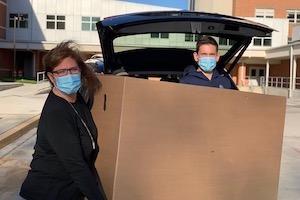In the Community
Professor Delivers 200,000+ Pieces of PPE to Desperate Hospitals Dr. Trina Ulrich sends life-saving equipment to health workers on COVID-19 front lines

In just six weeks since the COVID-19 crisis began growing in the United States, Dr. Trina Ulrich has collected and delivered more than 200,000 pieces of desperately needed personal protective equipment (PPE) to doctors and nurses in DC and nine states across the nation. She coordinated the distribution of PPE to hospitals, hospices, free clinics, and nursing homes — wherever she heard it was most needed to protect medical staff from contracting and spreading the COVID-19 virus.
Ulrich, a medical doctor and mom of three kids aged 6 to 17, did all of this while working fulltime as a professorial lecturer in American University’s Department of Health Studies. She says the past six weeks have been a whirlwind of activity filled with “random acts of kindness and generosity” from a widely diverse group of people working together to help. They include an anonymous donor from Asia, entrepreneurs at 3-D printing plants in California’s Bay Area and Wyoming, teenagers driving through the dark to make PPE hospital drop-offs, and a suburban Maryland neighbor who constructs face shields in her garage.
“It All Happened So Fast”
It all started in early March when a neighbor told Ulrich that she had heard from a former high-school classmate who was living in Asia. The classmate was predicting that COVID-19 would hit the United States hard, and she wanted to help by purchasing PPE and sending it to health workers in the US. Her only request was to remain anonymous (Her request has been honored, and Ulrich still does not know her name or identity.)
At the time, Ulrich had already been closely following the pandemic chatter within the medical community, and she offered to reach out to medical school classmates and physician contacts to see what they needed. The response was overwhelming. Almost 25 doctors and nurses wrote back for PPE, asking for it to be shipped to their homes and to the hospitals where they work, in DC, Maryland, Virginia, New York, New Jersey, Connecticut, Washington, Florida, North Carolina, and Minnesota.
“Every single doctor and nurse I spoke with was begging for equipment,” Ulrich said.
A Desperate Need
Ulrich got to work with the goal of honoring every PPE request within four days, which was the deadline from the anonymous donor. She knew she was doing the right thing when she learned about a COVID-19 Emergency Room meeting at a major District of Columbia hospital, where brown paper bags and sharpies were passed around the table. Doctors and nurses were told to take a bag, write their names on it, and use it to store (and re-use) their N-95 masks from day to day.
Ulrich got busy coordinating, collecting and distributing PPE into late hours of the night. The donor in Asia started sending smaller than usual batches of masks and face shields because larger shipments sometimes mysteriously went missing in transit. Ulrich set up anonymous donation boxes outside her home and asked everyone she knew to spread the word. Neighbors made cash donations to help cover shipping expenses and started sewing masks. Ulrich would wake up in the morning to overflowing donation boxes. After everything was sorted, she made trips to the post office, and her teenage sons delivered the PPE to local hospitals.
At one point, a physician in New York City sent Ulrich a photo of a truck pulling up to her hospital, filled with masks and face shields. She wrote, “So many donations coming. Brings tears to my eyes!”
Then Ulrich was put in touch with 3-D printing companies in California and Wyoming. It was a bit of a gamechanger. Ulrich connected the companies with hospital procurement teams to share specs for masks and face shields and make sure the products would meet specifications. Then they produced the first 10,000 pieces for free, and Ulrich helped them distribute them. After that, the companies started working directly with hospital procurement teams, keeping prices as low as possible. It’s been a winning arrangement: the companies keep their workers employed, and medical workers get the equipment they desperately need at a reasonable cost.
A Natural Connector
For Ulrich, connecting with others has always come naturally. She was doing her Obstetrics & Gynecology Residency almost 17 years ago when she contracted a virus from an ICU patient. She was pregnant at the time and spent months in bed recovering. The experience changed the trajectory of Ulrich’s career. While on bedrest, she began studying integrative nutrition and became interested in focusing on the chronic diseases that lower the quality of life and health of so many Americans. She also experienced firsthand the struggles of patients in hospitals, and the well-meaning but conflicting advice that they often receive from healthcare workers.
Ulrich wanted to become a connector between patients and doctors. She approached DC’s Sibley Hospital first, and the hospital created a brand new position for her. It was an educator position within the Department of Obstetrics, designed to support and connect patients, nurses, lactation consultants, and physicians to improve care and outcomes. And at this same time, Ulrich went back to school to formally study integrative nutrition.
This focus eventually led Ulrich to American University’s MS in Nutrition Education Program, where she’s been teaching fulltime for four years. “I love it because my students are so motivated, and this generation sees the big picture and how they can make a real difference in health at the foundational level.”
Ulrich’s teaching goal is to give students the knowledge to go out into the world and spread the word. “Coming to AU, I knew many doctors and nurses have a need to learn more about nutrition, but since I’ve been here, I’ve learned that it’s so important for people in all different pockets of life to learn nutrition education. It belongs everywhere, not just within the healthcare field.”
